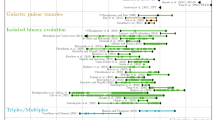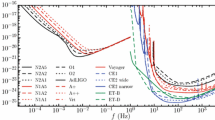Abstract
Mergers of compact object binaries have been considered the most promising sources of gravitational waves for ground based interferometric detectors. Investigating their properties was hampered by their elusive nature: only a handful are known. In this paper I review the estimates of the compact object merger rate density. This rate density can be estimated based directly on observations of objects that will merge, or using elaborate computer simulations of binary evolution. The two methods give consistent results, yet the uncertainties are still quite large. Nevertheless the current estimates point that the probability of detection of gravitational waves in the coming years is quite high.
Access this chapter
Tax calculation will be finalised at checkout
Purchases are for personal use only
Similar content being viewed by others
References
J. Abadie, B.P. Abbott, R. Abbott, M. Abernathy, T. Accadia et al., Topical review: Predictions for the rates of compact binary coale scences observable by ground-based gravitational-wave detectors. Class. Quantum Gravity 27(17), 173001 (2010). doi:10.1088/0264-9381/27/17/173001
K. Belczynski, V. Kalogera, T. Bulik, A comprehensive study of binary compact objects as gravitational wave sources: Evolutionary channels, rates, and physical properties. ApJ, 572, 407–431 (2002) doi:10.1086/340304
K. Belczynski, T. Bulik, B. Rudak, The first stellar binary black holes: The strongest gravitational wave burst sources. ApJ, 608, L45–L48 (2004). doi:10.1086/422172
K. Belczynski, R.E. Taam, V. Kalogera, F.A. Rasio, T. Bulik, On the rarity of double black hole binaries: Consequences for gravitational wave detection. ApJ, 662, 504–511 (2007) doi:10.1086/513562
K. Belczynski, T. Bulik, C.L. Fryer, A. Ruiter, F. Valsecchi, J.S. Vink, J.R. Hurley, On the maximum mass of stellar black holes. ApJ, 714, 1217–1226 (2010a). doi:10.1088/0004-637X/714/2/1217
K. Belczynski, M. Dominik, T. Bulik, R. O’Shaughnessy, C. Fryer, D.E. Holz, The effect of metallicity on the detection prospects for gravitational waves. ApJ, 715, L138–L141 (2010b). doi:10.1088/2041-8205/715/2/L138
K. Belczynski, T. Bulik, I. Mandel, B.S. Sathyaprakash, A.A. Zdziarski, J. Mikołajewska, Cyg X-3: A galactic double black hole or black-hole-neutron-star P rogenitor. ApJ, 764, 96 (2013). doi:10.1088/0004-637X/764/1/96
H.A. Bethe, G.E. Brown, Evolution of binary compact objects that merge. ApJ, 506, 780–789 (1998). doi:10.1086/306265
T. Bulik, K. Belczynski, Observational evidence for stellar mass binary black holes and their coalescence rate. Mem. Soc. Astron. Italiana 81, 302 (2010)
T. Bulik, K. Belczynski, A. Prestwich, IC10 X-1/NGC300 X-1: The very immediate progenitors of BH-BH binaries. ApJ, 730, 140 (2011). doi:10.1088/0004-637X/730/2/140
M. Dominik, K. Belczynski, C. Fryer, D.E. Holz, E. Berti, T. Bulik, I. Mandel, R. O’Shaughnessy, Double compact objects, I. The significance of the common envelope on merger rates. ApJ, 759, 52 (2012). doi:10.1088/0004-637X/759/1/52
M. Dominik, K. Belczynski, C. Fryer, D.E. Holz, E. Berti, T. Bulik, I. Mandel, R. O’Shaughnessy, Double compact objects, II. Cosmological merger rates. ApJ, 779, 72 (2013). doi:10.1088/0004-637X/779/1/72
S. Dong, A. Udalski, A. Gould, W.T. Reach, G.W. Christie et al., First space-based microlens parallax measurement: Spitzer Observations of OGLE-2005-SMC-001. ApJ, 664, 862–878 (2007) doi:10.1086/518536
J.M.B. Downing, M.J. Benacquista, M. Giersz, R. Spurzem, Compact binaries in star clusters - I. Black hole binaries inside globular clusters. MNRAS, 407, 1946–1962 (2010). doi:10.1111/j.1365-2966.2010.17040.x
J.M.B. Downing, M.J. Benacquista, M. Giersz, R. Spurzem, Compact binaries in star clusters - II. Escapers and detection rates. MNRAS, 416, 133–147 (2011). doi:10.1111/j.1365-2966.2011.19023.x
J. Grindlay, S. Portegies Zwart, S. McMillan, Short gamma-ray bursts from binary neutron star mergers in globular clusters. Nat. Phys. 2, 116–119 (2006). doi:10.1038/nphys214
C. Hopman, D. Guetta, E. Waxman, S. Portegies Zwart, The redshift distribution of short gamma-ray bursts from dynamically formed neutron star binaries. ApJ, 643, L91–L94 (2006). doi:10.1086/505141
J.R. Hurley, C.A. Tout, O.R. Pols, Evolution of binary stars and the effect of tides on binary popula tions. MNRAS, 329, 897–928 (2002). doi:10.1046/j.1365-8711.2002.05038.x
C. Kim, V. Kalogera, D. Lorimer, The effect of PSR J0737-3039 on the DNS merger rate and implications for gravity-wave detection. New A Rev. 54, 148–151 (2010). doi:10.1016/j.newar.2010.09.010
T. Kinugawa, K. Inayoshi, K. Hotokezaka, D. Nakauch i, T. Nakamura, Possible Indirect Confirmation of the Existence of Pop III Massive Stars by Gravitational Wave (2014) [ArXiv e-prints]
W.H. Lee, E. Ramirez-Ruiz, G. van de Ven, Short gamma-ray bursts from dynamically assembled compact binaries in globular clusters: Pathways, rates, hydrodynamics, and cosmological setting. ApJ, 720, 953–975 (2010). doi:10.1088/0004-637X/720/1/953
V.M. Lipunov, K.A. Postnov, M.E. Prokhorov, I.E. Panchenko, H.E. Jorgensen, Evolution of the double neutron star merging rate and the cosmological origin of gamma-ray burst sources. ApJ, 454, 593 (1995). doi:10.1086/176512
V.M. Lipunov, K.A. Postnov, M.E. Prokhorov, First LIGO events: Binary black holes mergings. New A 2, 43–52 (1997). doi:10.1016/S1384-1076(97)00007-9
T.J. Maccarone, B.D. Lehmer, J.C. Leyder, V. Antoniou, A. Hornschemeier, A. Ptak, D. Wik, A. Zezas, A new candidate Wolf-Rayet X-ray binary in NGC 253. MNRAS, 439, 3064–3072 (2014) doi:10.1093/mnras/stu167
M.N. Machida, K. Omukai, T. Matsumoto, S.I. Inutsuka, Conditions for the formation of first-star binaries. ApJ, 677, 813–827 (2008). doi:10.1086/533434
R.N. Manchester, G.B. Hobbs, A. Teoh, M. Hobbs, The australia telescope national facility pulsar catalogue. AJ, 129, 1993–2006 (2005). doi:10.1086/428488
T. Piran, N.J. Shaviv, Origin of the binary pulsar J0737-3039B. Phys. Rev. Lett. 94(5), 051102 (2005). doi:10.1103/PhysRevLett.94.051102
S.F. Portegies Zwart, L.R. Yungelson, Formation and evolution of binary neutron stars. A&A, 332, 173–188 (1998)
A. Sadowski, K. Belczynski, T. Bulik, N. Ivanova, F.A. Rasio, R. O’Shaughnessy, The total merger rate of compact object binaries in the local universe. ApJ, 676, 1162–1169 (2008). doi:10.1086/528932
K. Saigo, T. Matsumoto, M. Umemura, The formation of population III binaries. ApJ, 615, L65–L68 (2004). doi:10.1086/426389
A. Stacy, T.H. Greif, V. Bromm, The first stars: Formation of binaries and small multiple systems. MNRAS, 403, 45–60 (2010). doi:10.1111/j.1365-2966.2009.16113.x
A.V. Tutukov, L.R. Yungelson, A model for the population of binary stars in the galaxy. Astron. Rep. 46, 667–683 (2002). doi:10.1134/1.1502227
R. Voss, T.M. Tauris, Galactic distribution of merging neutron stars and black holes - prospects for short gamma-ray burst progenitors and LIGO/VIRGO. MNRAS, 342, 1169–1184 (2003) doi:10.1046/j.1365-8711.2003.06616.x
B. Willems, J. Kaplan, T. Fragos, V. Kalogera, K. Belczynski, Formation and progenitor of PSR J0737-3039: New constraints on the supernova explosion forming pulsar B. Phys. Rev. D, 74(4), 043003 (2006). doi:10.1103/PhysRevD.74.043003
Acknowledgement
This work was supported by the National Science Center, Poland with the grant number DEC-2013/01/ASPERA/ST9/00001.
Author information
Authors and Affiliations
Corresponding author
Editor information
Editors and Affiliations
Rights and permissions
Copyright information
© 2015 Springer International Publishing Switzerland
About this paper
Cite this paper
Bulik, T. (2015). The Coalescence Rates of Compact Object Binaries. In: Sopuerta, C. (eds) Gravitational Wave Astrophysics. Astrophysics and Space Science Proceedings, vol 40. Springer, Cham. https://doi.org/10.1007/978-3-319-10488-1_2
Download citation
DOI: https://doi.org/10.1007/978-3-319-10488-1_2
Published:
Publisher Name: Springer, Cham
Print ISBN: 978-3-319-10487-4
Online ISBN: 978-3-319-10488-1
eBook Packages: Physics and AstronomyPhysics and Astronomy (R0)




